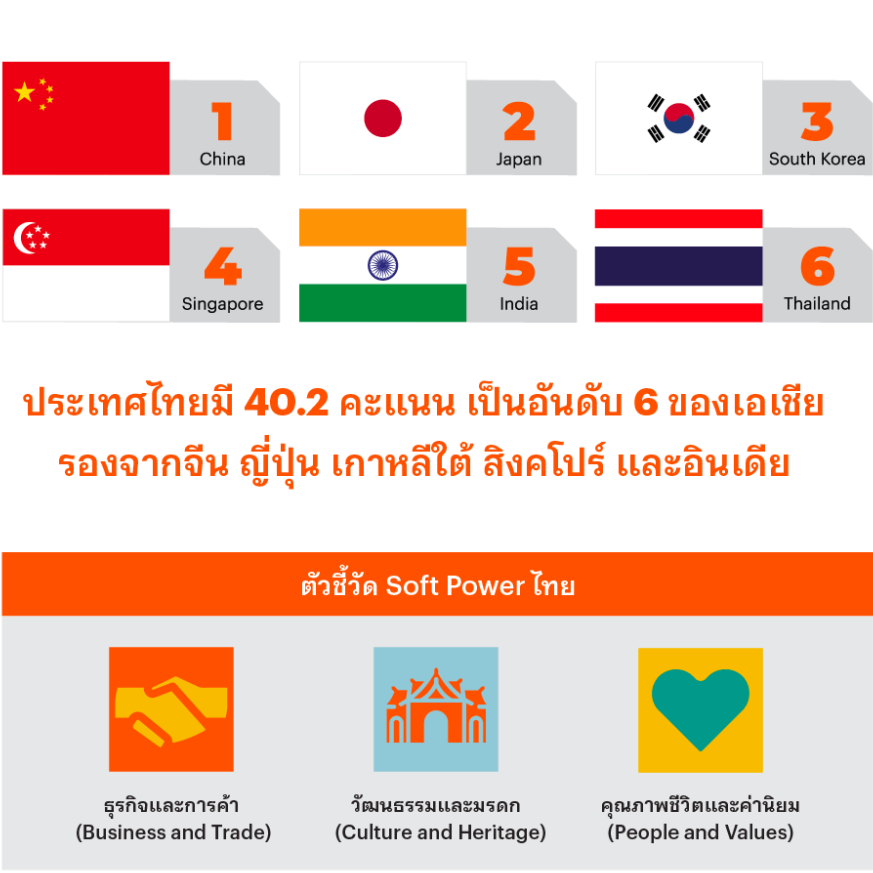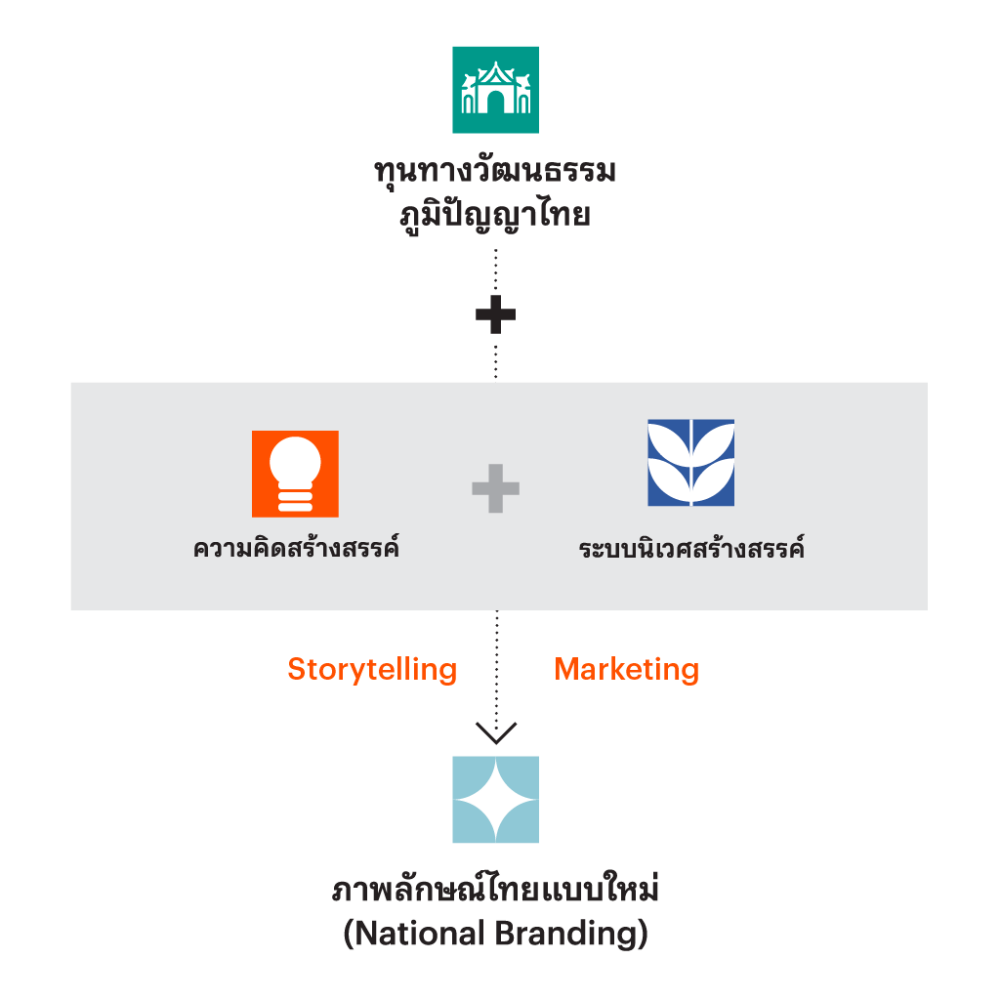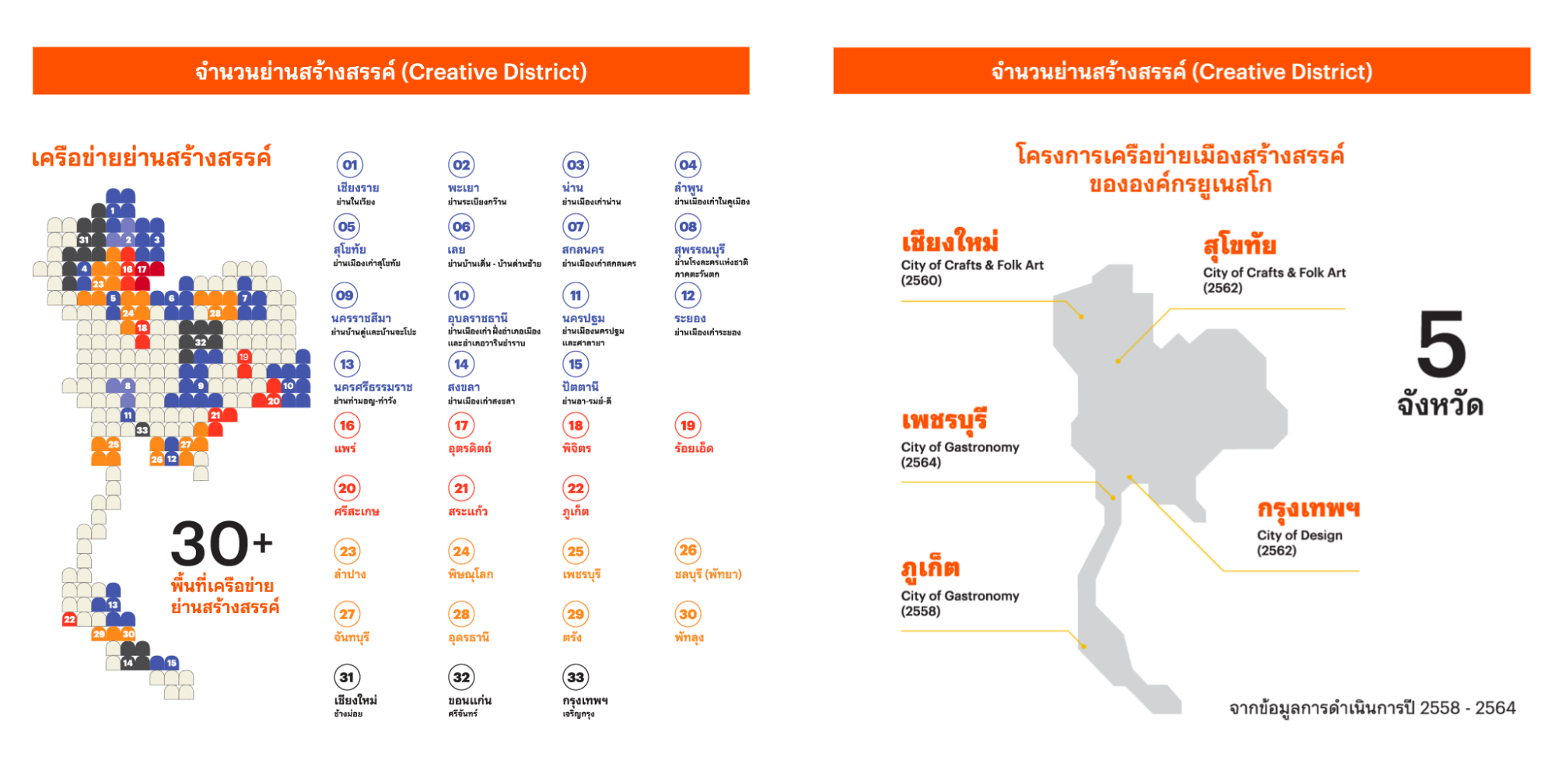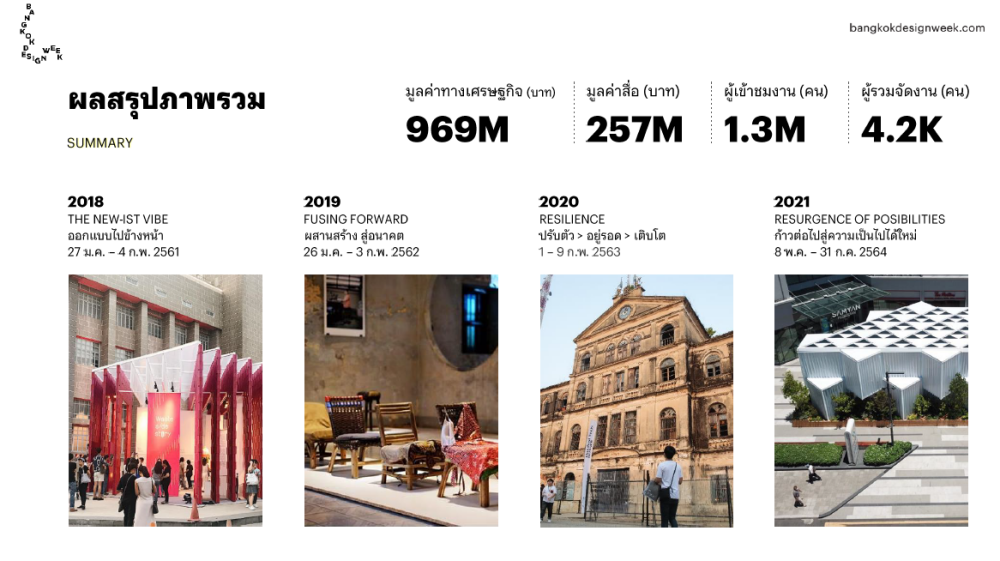Soft Power: The Driving Force of Creative Economy

The Soft Power phenomenon is widely becoming a trend, as can be seen in the success of music and film industries in which many countries have picked up their DNA as an essential component in developing their national brands such as South Korea's Creative Korea policy and Japan's Cool Japan, which are based on cultural costs, creativity, and technology. These factors play an essential role in creating tangible products and services. And they succeed throughout the world.
Thailand's Prime Minister, Prayut Chan-o-cha, and the government have emphasized the necessity of promoting Thai soft power and creative economy as one of the essential mechanisms for driving the economy, as well as exportation to maximize the country's worldwide potential.
Many Thai indie musicians are welcomed abroad, such as Milli by the mango sticky rice trend at Coachella 2022, The Paradise Molam Bangkok International Band, and Thai indie artists such as Phum Viphurit, PolyCat, Safeplanet, Yellow fang, TELEx TELEXs, and others. As a result, Thai music and arts have acquired international notice, resulting in a good response and the country becoming even more well-accepted.
So, what exactly is Soft Power?
The rise of soft power, which has the potential to produce enormous economic value for many nations throughout the world, has prompted us to consider what Thailand's soft powers are, and how they represent the country's identity and worth for the rest of the world to witness.
Delicate temples, exquisite Thai dances, Thai boxing, Tom Yum Kung, mango sticky rice, and a magnificent sea and white sand beach are all examples of Thai assets and highlighted components that are well-known by people around the world. Soft Power, on the other hand, has a broader definition than simply exporting Thai culture and products. Rather, it is one of the plans for the advancement of economic, social, and international relations.

Soft Power is a process, not a culture
Joseph S. Nye, Jr., who introduces the soft power concept, has described it as the power to convince others to be willing to do as demanded, with a gentle approach, rather than to coerce.
Therefore, soft power refers to a “strategy” or “mechanism” for a country to gain bargaining power through cultural appeals, media, travels, or other forms of foreign policy to infiltrate and cultivate a set of ideas and images (National Branding) that the country wants the world to recognize. Implementing soft power is a long-term approach that requires systematic planning and precise goal-setting.
Soft power is much more than just a simple strategy for exporting culture; it is a metric for the effectiveness of social and economic policies that represent a country's strengths and potential advantages of the country to other countries.
Where is Thailand’s soft power among other countries?
Due to Global Soft Power Index 2022 by Brand Finance, Thailand is ranked 35th out of 120 countries around the world, with 40.2 points, which is an increase from 38.7 points in 2021.
In Asia, Thailand is ranked 6th, following China, Japan, South Korea, Singapore, and India.
Out of the 7 main soft power indicators, Thailand has a high score in Business and Trade, Culture and Heritage, and People and Values. This reflects our strengths as having a clear cultural cost. But the Thai government must support the mechanisms for independence and not obstruct the extension of culture. This is a reflection of our strengths, which include a distinct cultural cost. However, the government must promote autonomous mechanisms rather than obstruct cultural expansion.

Creativity: a key to the expansion
So how to make exported Thai assets and stuff attractive enough?
The key driving force in the soft power process is the utilization of creativity and technology to increase economic value and build on the cultural assets and wisdom to improve both income and quality of life of people. This includes the establishment of the creative ecosystem, which will lead to the atmosphere, environment, and social structure in which creativity may seamlessly flourish.
As a result, creativity is a powerful motivator that encourages Thais to think outside the box and develop new business models that reflect Thailand's new image and bring the local identities and Thai featured products and services of Thailand to the world stage.

Soft Power: Resurrection of Thai Economy via Y Series
The Y series phenomenon has been a trend in the Thai film industry for the past 2-3 years. It has progressed from niche to mainstream content, resulting in the emergence of a new economic system known as the "Y Economy," which earns revenue from both local and global fans.
Currently, Thailand is one of the world's leading Y-series producers and no.1 in Asia. Thai Y series is very popular in Taiwan, Indonesia, and the Philippines, with a total market value of over 1,000 million baht. This reconfirms the quality and effective leadership in creative content production. According to the Department of International Trade Promotion (DITP), in the online business matching event in June 2021, the top three countries that are most interested in buying Thai Y content are Japan, Taiwan, and Vietnam, and Y content had the potential to make up to 360 million baht. Y contents generated up to approximately 360 million baht, whereas, in 2021, the overall economic value of the creative industry in the film and video branch was 1,585 million baht, while the broadcasting branch (series and film) was 32,463 million baht.
How far can the Thai creative industry go on the world stages?
Apart from Y series, the film “Medium”, an international co-produced horror film between Thailand and South Korea, has presented the haunting story of ancestral spirits according to the native ethnicity of the Isan region. The film was made in a thriller mockumentary style. The film has made a phenomenon both at home and overseas with $8.52-million revenue. It was exported to multiple countries, both in Latin America such as Mexico and Colombia, and in Asia such as South Korea, Hong Kong, and Singapore. The Medium was also listed in the top ten on the biggest streaming platform Netflix in Hong Kong and Singapore.

image: gdh559.com
T-Pop has also been a phenomenon over the past few years. This is not limited only to the Boy Band or Girl Group, but it includes all of the genres of Thai music which the strength of Thailand is “musical diversity.” In the previous years, the Thai indie music industry or “Indie Pop” has tremendously grown. Independent music communities in foreign countries are interested in Thai artists which led to the opportunities for Thai music bands to go on tour in Asia and around the world.
Ink-Waruntorn Paonil and Danupha Khanatheerakul or Milli are the two Thai female solo artists who won awards in Mnet Asian Music Awards 2020 in South Korea. Sukolwat Phuangsombat or Sprite, is a 15-year-old Thai rapper whose song "Ton" was the first Thai song to rank on the Billboard Global chart at no.89, as well as 4Mix, the first LGBTQ+ group in Thailand to go into the market in Latin America and Europe, and they are nominated for the People's Choice Awards in the Korean’s music event 36th Golden Disc Awards in 2022. This is considered a success for the Thai music industry on the global stage.

image: yuppentertainment.com และ khaosanentertainment.com
Besides, the music industry helps contribute to the economy, hiring, publicizing Thai cultures, as well as increasing awareness of the diversity to the society. The Thai music sector was valued at 1.4 billion baht last year, with an average annual growth rate of 6.5 percent.
CEA as the Facilitator and Connector
Creative Economy Agency (Public Organization) or CEA plays an important role as the Facilitator of soft power to truly happen, through the missions to develop the creativity of Thai people, assist in the creation of a creative ecosystem, and support the competitiveness of Thailand’s creative industry. It is also responsible for introducing the value of Soft Power in the same picture to all sectors.

1. Creative Business
- Measures to support the filming of foreign films in Thailand: CEA has collaborated with the Department of Tourism, Ministry of Tourism and Sports to implement the supportive measures for the filming of foreign film productions such as a new cash rebate rate for the productions and the improved work permit and income tax exemption rules for simpler access and to attract the film productions into Thailand.

- Lampang Monster: SMEs development program through the creation of new characters to create a strong branding of local SMEs in Lampang.

2. Creative Place

- Thailand Creative District Network or TCDN: A platform to build a system for provincial area development via creativity and design work, which helps add value to the existing assets, improve quality of life, and revitalize the old neighborhood.
- UNESCO Creative Cities Network or UCCN: An international city development platform that facilitates the strategic exchange of art and cultures, creativity, information, experiences, personnel, projects, and activities with other cities in the network across the world. On the international scale, it is also advantageous for city public relations in terms of commerce, investment, and tourism.
- A platform to demonstrate Thai creative people’s potentials and creative businesses. Design Week is considered a cultural product that boosts the local economy and generates revenue from tourism. It has the potential to be elevated into a world-class festival once it is well-managed and able to present a fascinating story. Design Week is also a destination for travelers around the world who would like to explore new experiences in life.

CEA has collaborated with private sectors, communities, and local government agencies in arranging the creative festivals. For example, Bangkok Design Week has been held 5 times already. It is the biggest design festival in Southeast Asia and attracts a total of over 400,000 visitors each year.
For the regional scale, CEA conducts Chiang Mai Design Week and Isan Creative Festival which showcase the local identity and provide the opportunity for local enterprises and communities to benefit from creativity. The festivals help make cities become creative cities that will open up new opportunities and export Thai identity in unique ways to the world.
3. Creative People
- Sound of the City: The project to showcase the potential of music artists to create songs that portray the identity of their beloved districts or cities. Over 100 songs of the cities such as Charoenkrung, Bangkok, Nimmanahaeminda Chiang Mai, Pattaya, Songkhla, Koh Samui, etc., are now available on CEA platform.
- “Made in” Project: The project to build on the local businesses in various districts by combining the skills of the local craftsmen and the creativity of people of the new generation to create the products and services that meet the demands of customers more. The collaboration also helps promote the featured products of all areas throughout Thailand which contains a sense of antiqueness with a new look and unexpected new possibilities.



